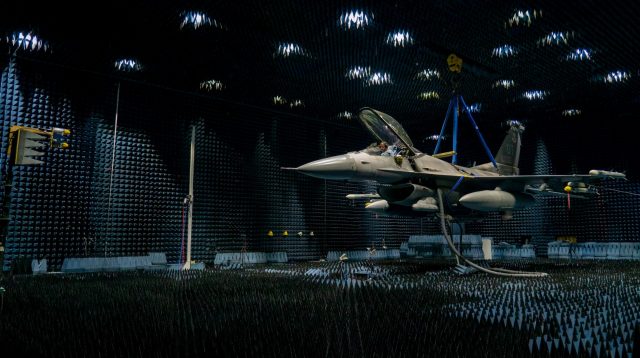The US Air Force is trialing the use of open-source technology that could allow it to upgrade its electronic warfare/electromagnetic systems as easily as installing a new app on a smartphone.
The service’s new Angry Kitten electronic attack combat pod showcased the capability for rapid reprogramming between flights in recent tests, receiving upgrades overnight.
This combat pod, an updated version of the Georgia Tech Research Institute Angry Kitten pod, simulates enemy electronic attack signals during Air Force test and training missions.
Given the success of the pod in training and demonstrated ability to be reprogrammed, Air Combat Command recommended four pods be converted into combat pods to provide attack capabilities against enemy radio frequency threat systems, instead of simulating them.
The experiment aimed to show how this new government-owned architecture could be used to better counter threat systems that use software-defined radars to quickly change their radio frequency signature to make it more difficult for US aircraft to identify and attack them.
Historically, Air Force electronic warfare systems were designed to have tightly coupled software and hardware, which were effective, but also took considerable time and funding to update. The Angry Kitten architecture provides greater flexibility to update or reprogram the system as the electronic warfare environment changes.
Similar to a smartphone and digital app store, today’s electronic warfare/electromagnetic systems need to be quickly updated or loaded with new software to defeat complex emitters and constantly changing electromagnetic systems threats, Keith Kirk, the experiment program manager, said.
“The hardware and software stovepipe solutions prevalent throughout the Air Force enterprise significantly impair the Air Force’s ability to quickly adapt and defeat new emerging electromagnetic systems threats,” he said. “App-Enabled Rapidly Reprogrammable Electronic warfare/electromagnetic Systems experiment campaign (AERRES) is demonstrating open hardware/software solutions that allow platforms to upgrade capability by swapping hardware modules and/or software apps to change electromagnetic systems offensive and defensive effects.”
The Operational Flight Program Combined Test Force tested the Angry Kitten electronic countermeasures combat training pod on board an F-16 Fighting Falcon assigned to the 53rd Wing at the Joint Preflight Integration of Munitions and Electronic Systems, or J-PRIMES, test facility at Eglin Air Force Base, Florida.
Lt. Col. Stephen Graham, the Angry Kitten Combat Pod operational assessment test director, said during the two-week test, the self-defense jamming pod’s mission data file software was updated overnight to improve performance seen against threats each day.
Graham, who is also the F-16CM electronic warfare test director for Air Combat Command’s Operational Flight Program Combined Test Force, said the government-owned software allows programmers to update the software and install new mission data files without delay.
The data files use an open-source programming language, which enables programmers to design effective jamming techniques against threats with known radio frequency signature data. Graham said the techniques were evaluated over many months to improve accuracy and efficiency. Multiple organizations, including the 36th Electronic Warfare Squadron, Georgia Tech Research Institute, Air National Guard-Air Force Reserve Test Center and the US Air Force Air Warfare Center, worked to ensure the most current techniques were programmed.
Before the flight test event, programmers developed the specific mission data files for the system, and the team worked with the Air Force Life Cycle Management Center’s Agile Combat Support Directorate to verify and validate these updates in labs at Robins Air Force Base, Georgia. Team members created next-day data file updates at Nellis Air Force Base, Nevada, during the operational assessment.
“The flexibility of the Angry Kitten technique description language enabled daily mission data file changes based on open-air testing observations to enhance effectiveness against a multi-threat environment,” Graham said.
He noted the operational assessment aimed to identify effectiveness and suitability of the combat pod and provide operational feedback to inform Air Combat Command on a potential future fielding decision.
The test team completed 30 sorties and demonstrated post-flight reprogramming to improve effects seen in earlier flights.
“The flight test at China Lake was our final operational assessment event,” Kirk said. “The software was updated within hours based on the performance they were seeing against certain threats and then was improved, and those improvements were verified during flight test the following day. That’s really tough to do with software and tools that are not designed to open standards.”
Kirk said while the future of Angry Kitten Combat Pod is still undecided, the program has dramatically shaped the direction of electronic warfare in the Air Force.
“The AERRES experiment is demonstrating app-like capabilities for the 350th Spectrum Warfare Wing, and the electronic warfare enterprise in general,” Kirk added. “We are making great progress toward software-enabled electronic warfare systems that allow us to quickly update our effects based on the changes in the radio frequency environment and the type of effects that we want to make happen.”
Graham said he expects the open architecture software work of Air Force Research Laboratory and the new Spectrum Warfare Wing will benefit more DOD systems in the future.
“It’s an exciting time to be working to improve our electronic warfare capabilities,’’ Graham said.



























